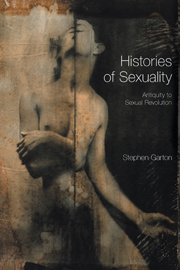Book contents
- Frontmatter
- Dedication
- Contents
- Preface
- 1 Writing Sexual History
- 2 Rule of the Phallus
- 3 Sexual Austerity
- 4 Christian Friendships
- 5 Making Heterosexuality
- 6 Victorianism
- 7 Dominance and Desire
- 8 Feminism and Friendship
- 9 Imagining Perversion
- 10 Normalizing Sexuality
- 11 Sexual Revolution
- Epilogue
- Endnotes
- Select Bibliography
- Index
9 - Imagining Perversion
- Frontmatter
- Dedication
- Contents
- Preface
- 1 Writing Sexual History
- 2 Rule of the Phallus
- 3 Sexual Austerity
- 4 Christian Friendships
- 5 Making Heterosexuality
- 6 Victorianism
- 7 Dominance and Desire
- 8 Feminism and Friendship
- 9 Imagining Perversion
- 10 Normalizing Sexuality
- 11 Sexual Revolution
- Epilogue
- Endnotes
- Select Bibliography
- Index
Summary
Richard von Krafft-Ebing, in his influential study of perversion Psychopathia Sexualis (1886), pleaded ‘few people ever fully appreciate the powerful influence that sexuality exercises over feeling, thought, and conduct’. ‘The importance of the subject demands’, he explained, ‘that it should be examined scientifically.’ Many took up his challenge. By some estimates there were more than 10,000 monographs and articles relating to sexuality published in German alone between 1886 and 1933, 1,000 on homosexuality between 1898 and 1908. In turn the late-nineteenth and early-twentieth centuries have been of intense interest for historians of sexuality. For Steven Marcus, this period represents the moment when Freud was able to wash away the ignorance of the Victorian repression. Commonly historians have seen the pioneers of sexology, such as Krafft-Ebing, Havelock Ellis, Magnus Hirschfeld and Sigmund Freud, as the progenitors of modern scientific understandings of sexuality. More recently, historians such as John D'Emilio and Estelle Freedman, have seen this period ushering in the ‘sexual liberalism’ of the 1920s.
Other historians, however, have questioned the idea of a decisive break between Victorian ignorance and a new age of ‘scientific’ understandings of sex. Frank Sulloway, for example, has argued that Freud was deeply influenced by the vast range of pseudo-scientific ideas that were popular in nineteenth-century Europe and America. More importantly, Michel Foucault has argued that the fundamental tools of psychoanalytic practice – talking, transference, dream analysis and free association – have their roots in older technologies of confession rather than a new scientific approach to sex.
- Type
- Chapter
- Information
- Histories of SexualityAntiquity to Sexual Revolution, pp. 169 - 188Publisher: Acumen PublishingPrint publication year: 2004



